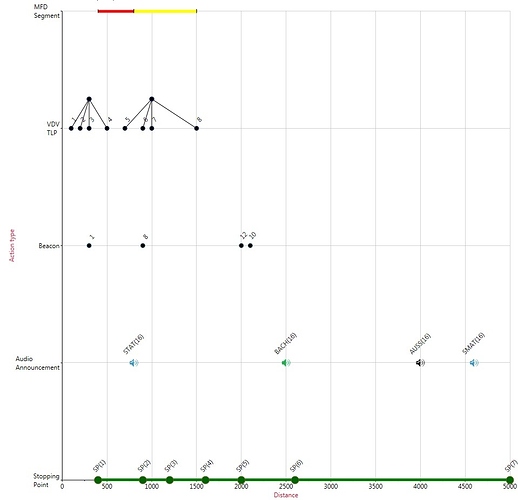Sure, here’s the start of your kind of diagram:
<!-- Copyright © Northwoods Software Corporation, 2008-2016. All Rights Reserved. -->
<UserControl x:Class="XYChart.XYChart"
xmlns="http://schemas.microsoft.com/winfx/2006/xaml/presentation"
xmlns:x="http://schemas.microsoft.com/winfx/2006/xaml"
xmlns:go="http://schemas.nwoods.com/GoXam"
xmlns:local="clr-namespace:XYChart">
<UserControl.Resources>
<!-- Node DataTemplates -->
<go:DataTemplateDictionary x:Key="DTD">
<!-- the default template -->
<DataTemplate x:Key="">
<go:SpotPanel go:Node.Location="{Binding Path=Data.Location}"
go:Node.LocationSpot="Center"
go:Node.LocationElementName="myCircle"
go:Part.SelectionAdorned="True">
<Ellipse x:Name="myCircle"
go:Node.PortId=""
Fill="{Binding Path=Data.Color}" Stroke="{x:Null}"
Width="8" Height="8" />
<TextBlock Text="{Binding Path=Data.Text}"
FontSize="9"
go:SpotPanel.Spot="MiddleTop" go:SpotPanel.Alignment="MiddleBottom">
<FrameworkElement.RenderTransform>
<RotateTransform Angle="-45" />
</FrameworkElement.RenderTransform>
</TextBlock>
</go:SpotPanel>
</DataTemplate>
<!-- templates for axis labels -->
<DataTemplate x:Key="LabelY">
<TextBlock Text="{Binding Path=Data.Text}"
FontSize="9"
go:Node.Location="{Binding Path=Data.Location}"
go:Node.LocationSpot="MiddleRight" />
</DataTemplate>
<DataTemplate x:Key="LabelX">
<TextBlock Text="{Binding Path=Data.Text}"
FontSize="9"
go:Node.Location="{Binding Path=Data.Location}"
go:Node.LocationSpot="MiddleTop" />
</DataTemplate>
</go:DataTemplateDictionary>
<DataTemplate x:Key="LinkTemplate">
<go:LinkPanel>
<go:LinkShape Stroke="{Binding Path=Link.FromNode.Data.Color}" />
</go:LinkPanel>
</DataTemplate>
</UserControl.Resources>
<Grid>
<go:Diagram x:Name="myDiagram"
HorizontalContentAlignment="Stretch"
VerticalContentAlignment="Stretch"
NodeTemplateDictionary="{StaticResource DTD}"
LinkTemplate="{StaticResource LinkTemplate}"
IsReadOnly="True"
GridVisible="True">
<go:Diagram.GridPattern>
<go:GridPattern CellSize="50 100">
<!-- vertical lines -->
<Path Stroke="LightGray" StrokeThickness="1"
go:GridPattern.Figure="VerticalLine" />
<!-- horizontal lines -->
<Path Stroke="LightGray" StrokeThickness="1"
go:GridPattern.Figure="HorizontalLine" />
</go:GridPattern>
</go:Diagram.GridPattern>
<!-- the vertical axis -->
<go:Node>
<Line go:Node.Location="0 0"
X1="0" Y1="0" X2="0" Y2="300"
Stroke="Black"
go:Part.Selectable="False" />
</go:Node>
<!-- the horizontal axis -->
<go:Node>
<Line go:Node.Location="0 300"
X1="0" Y1="0" X2="300" Y2="0"
Stroke="Black"
go:Part.Selectable="False" />
</go:Node>
</go:Diagram>
</Grid>
</UserControl>
And here’s how the model was built in code:
/* Copyright © Northwoods Software Corporation, 2008-2016. All Rights Reserved. */
using System.Collections.ObjectModel;
using System.Windows;
using System.Windows.Controls;
using Northwoods.GoXam.Model;
namespace XYChart {
public partial class XYChart : UserControl {
public XYChart() {
InitializeComponent();
// create the diagram's data model
var model = new GraphModel<Dot, int>();
model.NodesSource = new ObservableCollection<Dot>() {
// don't use Key==0
new Dot() { Category="LabelY", Location=new Point(0, 100), Text="VDV\nTLP" },
new Dot() { Key=1, Location=new Point(10, 100), Text="1" },
new Dot() { Key=2, Location=new Point(20, 100), Text="2" },
new Dot() { Key=3, Location=new Point(30, 100), Text="3" },
new Dot() { Key=4, Location=new Point(50, 100), Text="4" },
new Dot() { Key=5, Location=new Point(130, 100), Text="5" },
new Dot() { Key=6, Location=new Point(150, 100), Text="6" },
new Dot() { Key=101, Location=new Point(50, 50), ToKeys=new ObservableCollection<int>() { 1, 2, 3, 4 } },
new Dot() { Key=102, Location=new Point(150, 50), ToKeys=new ObservableCollection<int>() { 5, 6 } },
new Dot() { Category="LabelY", Location=new Point(0, 200), Text="Stopping\nPoint" },
new Dot() { Key=11, Location=new Point(40, 200), Text="SP(1)", ToKeys=new ObservableCollection<int>() { 12 }, Color="Green" },
new Dot() { Key=11, Location=new Point(90, 200), Text="SP(2)", ToKeys=new ObservableCollection<int>() { 13 }, Color="Green" },
new Dot() { Key=11, Location=new Point(120, 200), Text="SP(3)", ToKeys=new ObservableCollection<int>() { 14 }, Color="Green" },
new Dot() { Key=11, Location=new Point(160, 200), Text="SP(4)", ToKeys=new ObservableCollection<int>() { }, Color="Green" },
new Dot() { Category="LabelX", Location=new Point(50, 300), Text="500" },
new Dot() { Category="LabelX", Location=new Point(100, 300), Text="1000" },
new Dot() { Category="LabelX", Location=new Point(150, 300), Text="1500" },
new Dot() { Category="LabelX", Location=new Point(200, 300), Text="2000" },
new Dot() { Category="LabelX", Location=new Point(250, 300), Text="2500" }
};
myDiagram.Model = model;
//this.DataContext = model;
}
}
// the data for each node
public class Dot : GraphModelNodeData<int> {
public Dot() {
this.Location = new Point(0, 0);
}
public string Color
{
get { return _Color; }
set
{
if (_Color != value) {
string old = _Color;
_Color = value;
RaisePropertyChanged("Critical", old, value);
}
}
}
private string _Color = "Black";
}
}
The above code produces this diagram:


